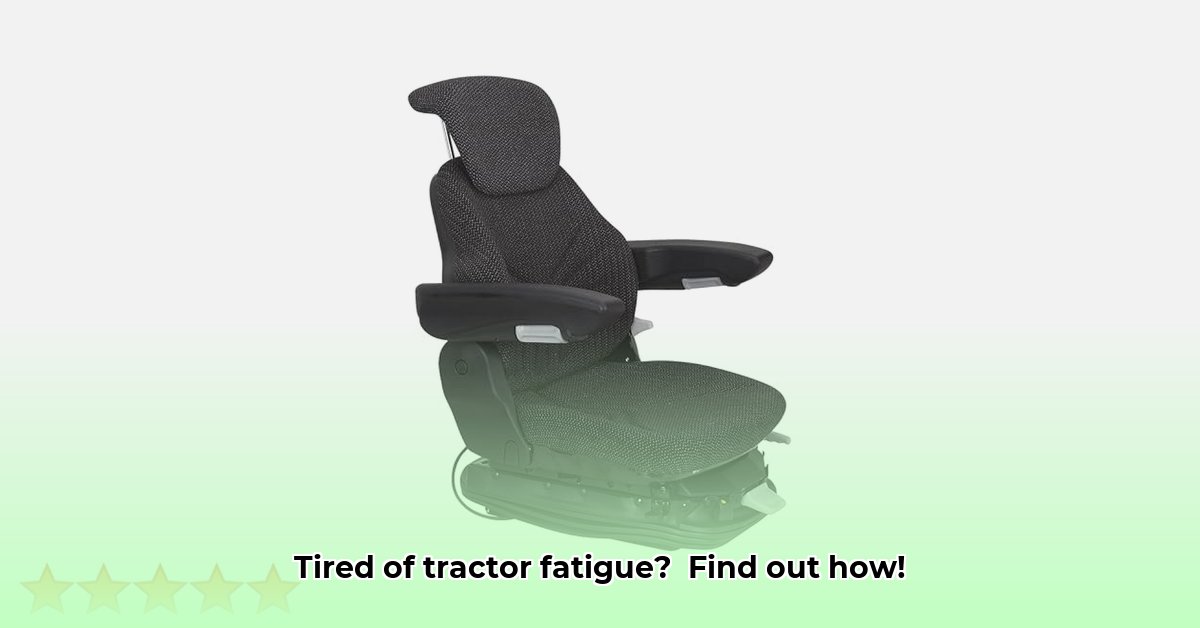
Air Ride Seat Tractors: A Smoother Ride, a More Productive You
Farming is demanding. Long days spent on bumpy terrain take a toll on operators, leading to fatigue, discomfort, and reduced productivity. Air ride seat tractors offer a solution, significantly improving operator well-being and efficiency. This isn't just about comfort; it's about bolstering safety and boosting your bottom line. Consider the impact of an uncomfortable seat on a long workday. The jarring, repetitive motions lead to fatigue, aches, and reduced focus – a dangerous combination for operating heavy machinery. For more tractor accessory options, check out this helpful resource.
The Comfort Factor: Your Back Will Thank You
Air ride seats act as shock absorbers, smoothing out bumps and vibrations. This results in a dramatically more comfortable ride, reducing fatigue and increasing alertness. A comfortable operator is a safer, more productive operator. Isn't investing in your operator's well-being a smart business decision?
Safety: It's Not Just a Feature, It's a Priority
Operator fatigue is a leading cause of agricultural accidents. Air ride seats directly combat this. By reducing fatigue and improving comfort, they help maintain focus and quick reaction times, leading to significantly fewer accidents. This simple upgrade demonstrates a tangible commitment to the safety of your valued workforce.
Beyond the Bounce: Ergonomics for a Healthier You
Modern air ride seats offer more than just suspension. Many incorporate ergonomic features like adjustable lumbar support, armrests, and even heating/cooling, promoting better posture and reducing the risk of musculoskeletal injuries. These features contribute to a healthier workforce and minimize the long-term health costs associated with repetitive strain injuries. Consider the impact on long-term healthcare costs – a well-designed seat is an investment in your operational efficiency.
Choosing Your Perfect Seat: What to Look For
Selecting the right air ride seat requires careful consideration:
- Suspension Style: Air suspension systems offer superior adaptability to changing terrain. Assess your typical working conditions to choose the system that best fits your needs.
- Adjustability: A highly adjustable seat ensures a perfect fit for each operator, improving comfort and minimizing strain. Highly adjustable options are essential for accommodating diverse body types and preferences.
- Durability: Look for durable materials and robust construction to withstand daily use in demanding environments. Investing in a quality seat translates to lower replacement costs in the long run.
- Additional Features: Consider features like heated/cooled seats or integrated safety features, depending on your climate and operational requirements. These features enhance comfort and contribute to a safer work environment.
Installing Your New Seat: A Step-by-Step Guide
Upgrading your tractor seat involves these key steps:
- Assessment: Identify current seat shortcomings and gather operator feedback to determine needs and priorities.
- Research & Selection: Thoroughly research available models, comparing features, prices, and compatibility.
- Professional Installation: Professional installation is highly recommended to ensure correct functionality and safety. Improper installation is a significant safety hazard.
- Operator Training: Provide thorough training on seat adjustment and feature utilization to maximize comfort and functionality.
The Long-Term Payoff: Boosting Productivity and Profits
While the initial investment in air ride seats may be substantial, the long-term benefits, including reduced fatigue, increased productivity, and fewer accidents, significantly outweigh the cost. A comfortable operator is a productive operator. This translates to higher efficiency, lower healthcare costs, and ultimately, improved profitability.
Air Ride Seats: Weighing the Pros and Cons
| Feature | Pros | Cons |
|---|---|---|
| Comfort | Significantly reduces fatigue and back pain, improving operator well-being. | Higher initial cost compared to standard seats. |
| Safety | Improves alertness and reaction times, resulting in fewer accidents. | Requires regular maintenance (e.g., air pressure checks). |
| Productivity | Enables longer working hours without excessive fatigue, increasing output. | Installation might require professional assistance, adding to overall costs. |
| Ergonomics | Customizable features improve posture and mitigate musculoskeletal issues. | Some features (heating/cooling) may consume additional energy. |
How to Choose the Best Forklift Seat Suspension System for Operator Comfort and Safety
Understanding the Importance of Forklift Seat Suspension
A comfortable, well-designed forklift seat is crucial for operator safety and productivity. Vibration from rough terrain and heavy loads causes fatigue and health issues. A superior suspension system acts as a critical buffer, significantly reducing these harmful effects. Consider the long-term impacts of vibration exposure on worker health—a comfortable seat is a vital investment in your workforce.
Choosing the Right Suspension System: A Step-by-Step Guide
Selecting a suitable suspension begins with understanding what's needed:
- Needs Assessment: Evaluate terrain conditions, operation duration, and operator needs.
- Suspension Types: Consider mechanical, pneumatic (air-ride), and hydro-pneumatic options, each with its own strengths and weaknesses.
- Ergonomic Features: Prioritize adjustable lumbar support, seat height, and tilt for optimal comfort and posture.
- Materials: Choose durable and easy-to-clean materials like vinyl, or prioritize comfort with cloth.
- Safety Features: Ensure seatbelts are included and consider presence sensors for enhanced safety.
- Budget and ROI: Balance the initial cost with long-term benefits like reduced injuries and increased productivity.
Pros and Cons of Different Suspension Systems
| Suspension Type | Pros | Cons |
|---|---|---|
| Mechanical | Affordable, reliable, simple maintenance | Less vibration dampening than other systems |
| Pneumatic (Air-Ride) | Superior comfort, excellent vibration absorption, adjustable firmness | Higher initial cost, potential for leaks and air pressure maintenance |
| Hydro-Pneumatic | Combines benefits of mechanical and pneumatic systems | Highest initial cost, more complex maintenance |
Beyond the Suspension: Ergonomics and Operator Training
Even with ideal suspension, proper ergonomics and operator training are paramount. Regular adjustments, proper posture, and knowledge of seat features are critical. Implement regular training programs focusing on the safe and efficient use of the forklift’s seat and features. Regular seat inspections and maintenance are vital for longevity and continued operator safety.